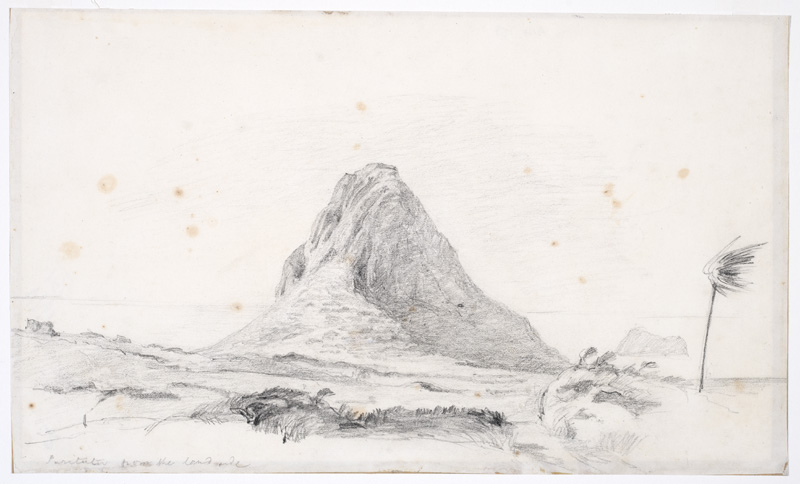
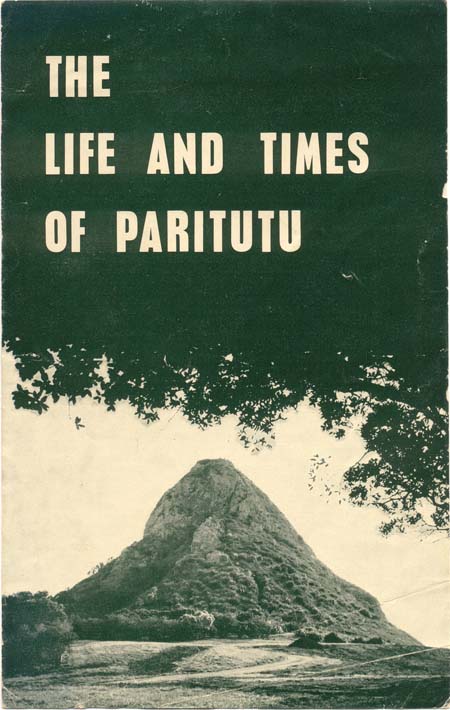
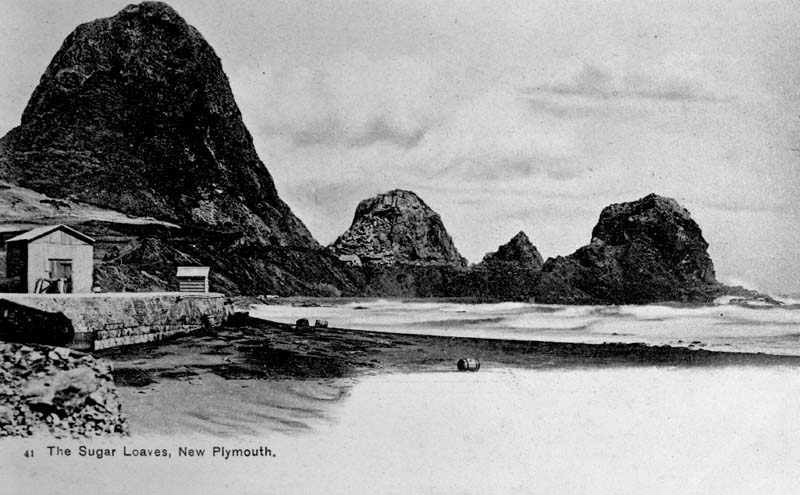
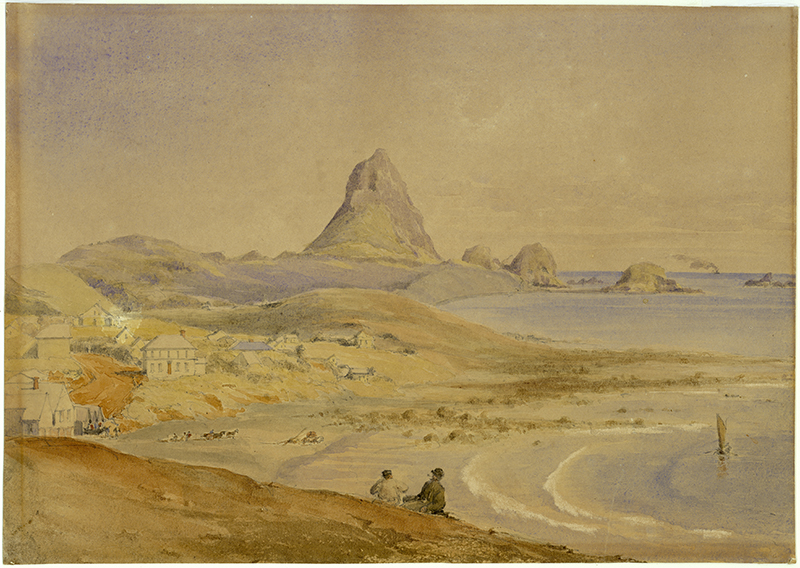
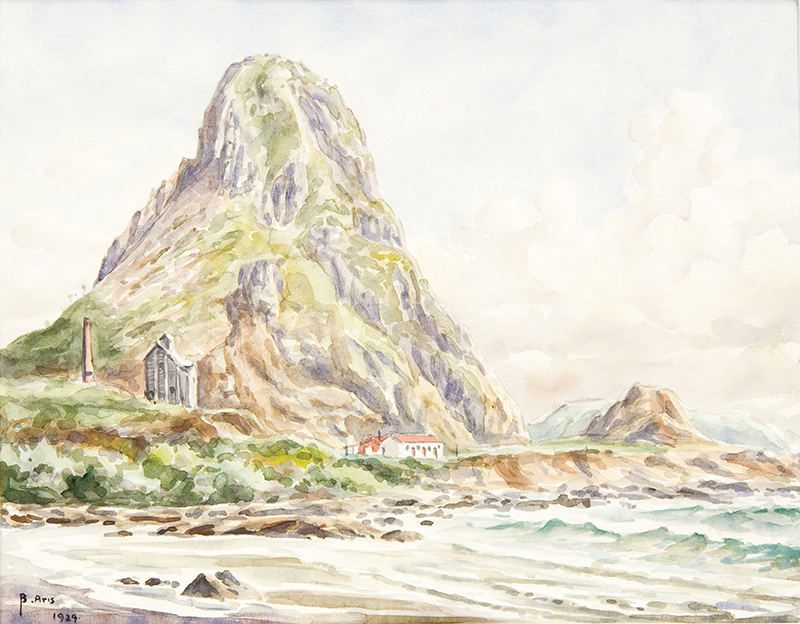

Look to the east of New Plymouth and you will see the towering monolith of Paritūtū, standing tall with the tide licking her toes. She's exactly as her name suggests, pari (cliff, high or flowing tide) tūtū (stand erect, violence).
At 153 metres, she is the tallest and most awesome part of the rim of an old volcano, much older than our mountain, Taranaki. She stands sentry at our port, next to the Sugar Loaf Islands: Motuotamatea (Snapper Rock), Motumahanga (Saddle Back), Pakaraki (Seagull Rock), Mataora (Round Rock), Wareumu (Lion Rock), Moturoa and Mikotahi.
There were once two more Sugarloaf Islands at Paritūtū's feet, carrying the single name of Fishing Rock. They sat where the power station is today. These two lumps, 40 metres and 44 metres high respectively, were quarried into extinction to build the long concrete wharf that now stretches into the sea.
If some of New Plymouth's founding fathers had had their way, it would have been Paritūtū who was sacrificed for the sake of a safe harbour after a plot was hatched to blow her to bits and use her innards for fill.
Paritūtū was first discovered by Pākehā in 1770 when Captain Cook sailed down the coast and named the islands after the lumps of sugar he put in his tea. Dicky Barrett was probably the first white man to climb the rock 58 years later, around 1828, followed by Frederick Carrington who went to the top to survey the site for a new settler town.
But occupation of the rock goes back to the earliest Māori times. When the HMS Alligator sailed by in 1834 to pick up survivors of the barque Harriet wrecked on the south Taranaki coast, the summit of Paritūtū looked like a porcupine, with heavy log palisades poking into the sky.
Paritūtū had once stood somewhat taller, perhaps a metre, but the summit had been flattened by sheer hard work to make a level site for whare and kūmara pits. Every available niche was widened for further shelter.
Drinking water was gathered in calabashes from a spring half way up the western face, reached by a brave volunteer lowered on a flax rope. A substantial village named Mahoe once sprawled at the bottom, famous for its tohunga school of learning.
All the Sugar Loaf Islands bear signs of ancient occupation, apart from Pakaraki which was unoccupied and kept as a source of seagull eggs.
It was first proposed in 1877 to take material from the bottom of Paritūtū and use it to form a breakwater, which was badly needed to further trade. Then came the plan to shave rock from the top, layer by gritty layer. More than a few good town folk objected, including solicitor H.R. Richmond who wondered, “Is it right to knock over Paritūtū to make a harbour?”
A deaf ear was turned to protests and a tunnel was drilled 30 metres into her flanks, with a chamber on each side to take a ton of blasting powder. On Saturday, 29 December 1879, crowds of eager sightseers hurried out to Moturoa to watch 'the great explosion'. A bevy of constables ordered them back to where the Moturoa shops are today.
At just after 3pm, the handle of the exploder was plunged. But all that issued forth was a gush of dirty smoke and a slight trembling was felt through the ground. All in all, a bit of a disappointment. Though an estimated 3600 metres of rubble had shattered and moved, tests showed that only a tiny amount could be quarried in blocks big enough to be useful.
The idea of mining Parituūtū's bones was shelved, and quarrying continued at Fishing Rock. When the Breakwater foundation stone was laid in 1881, Paritūtū held her head up high and peered down on the scene.
In 1906, the argument began again, whether the big rock should be mined for a harbour extension. The Commissioner of Crown Lands entered the ring with a strong recommendation from the Scenery Preservation Commission that Paritūtū be saved as a national reserve.
Successful local businessman Newton King thought it ridiculous to hand over ownership in case New Plymouth never got her back. But to others the harbour improvements were on top of their priorities list. “We can't live on scenery”, someone called Price said.
W.H. Skinner expressed his view that Paritutū should not be blasted unless it could be proved beyond doubt that good stone could be retrieved. He believed better rock could be had from Fishing Rock, where access was far easier.
In the end, the second call for destruction was thrown out, only to be raised again in 1921. 'There must be more wharfage,' came the cry and once more, all eyes looked to Paritūtū. Another blast was organised to determine the quality of her rock.
Conservation was not a popular concept in the 1920s, yet the fate of Paritūtū was discussed around the country. The Auckland Star put it best: “Operations at Paritutu raise the whole question of the preservation of places of sentimental, historic or aesthetic value. We do not know that there is anything to prevent what is happening at Paritutu bringing down many other places of equal or greater interest.”
A Paritūtū Preservation League was immediately set up, with Skinner as chairman. Money was to be raised to buy the whole rock from the Harbour Board, but as it turned out, the Board had no power to sell her. When the Minister of Mines appointed government geologist P.G. Morgan to give an opinion on the quality of rock, yet another test blast was planned. As a result, using the original 1879 site, 30,000 tons of rock came down.
Twice the quality of rock had been tested and twice it had been found wanting. Yet in Morgan's opinion, “a large stone of good quality” could still be quarried for the breakwater extension. The Dominion offered its opinion: “Economy is a thing to be sought in these days, but even the most economical of us must feel a twinge of regret at the destruction of the most remarkable feature on the Taranaki coast.”
The paper stepped up its campaign for the big rock's survival. “Paritutuwas spared once before and it would be welcome news to hear that even at this eleventh hour, some way may be found of saving this noble rock to which so many legends attach.”
But start a quarry they did. In 1922, at the base of Paritūtū, men on both day and nightshifts worked right around the clock.
It began hopefully enough. In 1923 another 800 kilograms of explosive was packed round Paritūtū's ankles and fired. This time, only about 7000 tons of small stone was dislodged. Another tunnel was drilled into the quarry face, with the next blast expected to provide enough “good rock” for two years.
But this last blast altered the shape of Paritūtū forever, blowing away her southern shoulder. Residents of Moturoa were both surprised and appalled, when they first caught sight of her. Skinner, who visited the quarry, labelled it a “melancholy sight”, and not a single stone turned out to be suitable for the harbour work. “After every blast fired into this hoary old sentinel”, he said, “we have been confidently informed that at last the great mass, the core, of superfine rock has been struck. But has it, or will it be?”
There were two more blasts that same year, and another two the next, but these turned into largely cleaning-up operations. No mention of quarrying Paritūtū was ever made again.
Finally, in 1941, the area was handed over to New Plymouth City Council, to be safely preserved for all time as Paritūtū Centennial Park. Even so, a power station was built beside it, with a chimney that stretches 30 metres higher than Paritūtū herself.
Puke Ariki Heritage Collection: Records of the Paritutū Centennial Park Committee
LinkPlease do not reproduce these images without permission from Puke Ariki.
Contact us for more information or you can order images online here.